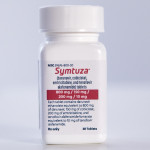People taking once-daily Norvir (ritonavir)–boosted Prezista (darunavir) monotherapy were able to maintain control over HIV for 96 week about as well as people who switched to Novir-boosted Prezista plus two nucleoside reverse transcriptase inhibitors (NRTIs). These data were presented Thursday, July 22, at the XVIII International AIDS Conference (IAC), taking place July 18 to 23 in Vienna.
Though not a common strategy in the United States, there has been global interest in whether it might be possible to control HIV with fewer antiretroviral (ARV) drugs, particularly as a means to reduce toxicity. The first drug studied in this manner was the protease inhibitor Kaletra, which is a fixed dose combination pill made up of lopinavir, boosted by small dose of ritonavir. In a number of studies, Kaletra monotherapy was pitted against Kaletra plus two NRTIs. Though monotherapy worked well, it never quite equaled the potency of the full three-drug combination.
More recent studies have found that Norvir-boosted Prezista might actually be more potent than Kaletra, and thus a good candidate for further monotherapy studies. Two studies of this strategy were reported at the Fifth International AIDS Society (IAS) Conference on Pathogenesis, Treatment and Prevention last year in Cape Town. One, called MONET, indicated that once-daily Norvir-boosted Prezista monotherapy (Prezista monotherapy) was equivalent in terms of potency and safety to a regimen that included two NRTIs over 48 weeks. A second study, called MONOI, found that twice-daily monotherapy was not equivalent to triple-drug treatment.
At IAC this year, Armin Rieger, MD, from the University of Vienna, reported on 96-week data from MONET. To recap: Researchers with MONET recruited 256 people who were taking ARV therapy and had a viral load of less than 50 copies. Roughly half switched to Prezista monotherapy, and half switched to Norvir-boosted Prezista plus two NRTIs.
While at 48 weeks people taking monotherapy had equivalent efficacy to those taking triple-drug therapy—regardless of which type of analysis was used—by 96 weeks, there began to be a slight difference between the two groups.
In one analysis, where people on monotherapy were not counted as failures if they switched to triple-drug therapy following a detectable viral load, Prezista monotherapy was statistically equivalent to triple-drug therapy. When switches were not allowed, however—when they were counted as treatment failures—monotherapy was found to be inferior to triple-drug therapy.
Rieger reported data that should be noted before rushing to the conclusion that monotherapy is simply inferior to triple-drug therapy. First, the participants in the study had extensive prior treatment experience. On average, people in both groups had been on ARV therapy for at least six years. Thus, it is possible that the results might have been different in people who had only recently begun taking ARVs.
Second, hepatitis C virus (HCV) infection and intravenous drug use (IDU) substantially explained the difference in efficacy between the two arms. The implications of this are not entirely clear, but they suggest that greater potency does matter more in people with HCV and in people who might have adherence challenges.
On the other hand, there were no significant benefits for people on monotherapy in terms of side effects. In fact, there were a higher number of moderate to serious increases in lipids (cholesterol and triglycerides) in the monotherapy group than in the triple-drug therapy group.
In conclusion, while these data are intriguing and do suggest that for at least some people, monotherapy can be just as potent as triple-drug therapy, it is unclear how the results should influence treatment decisions for people living with HIV.
Advertisement
Advertisement
Advertisement






Comments
Comments